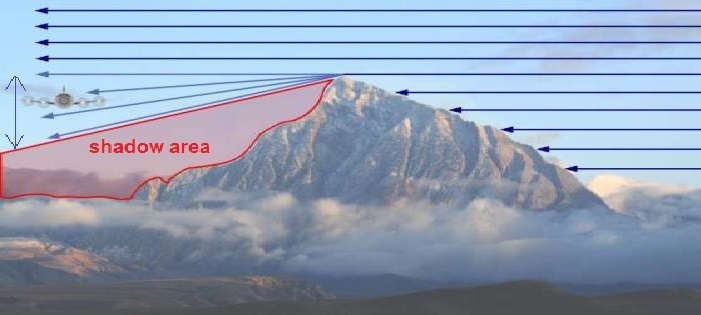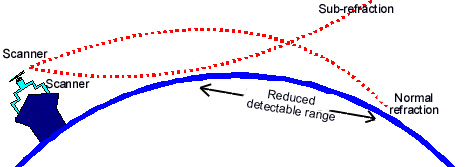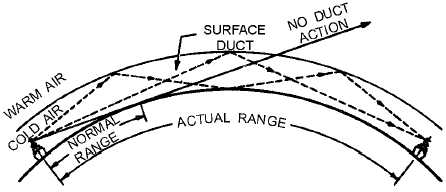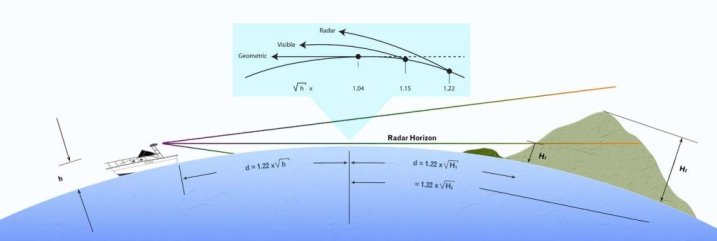THE HORIZON
The affect of the atmosphere on the horizon is a factor which should be taken into account when assessing the likelihood of detecting a particular target and especially where the coastline is expected.
DIFFRACTION

Diffraction is the bending of a wave as it passes an obstruction. Because of diffraction there is some illumination of the region behind an obstruction or target by the radar beam. Diffraction effects are greater at the lower frequencies. Thus, the radar beam of a lower frequency radar tends to illuminate more of the shadow region behind an obstruction than the beam of radar of higher frequency or shorter wavelength.
REFRACTION

Refraction affects the range at which objects are detected. The phenomenon of refraction should be well-known to every navigation officer. Refraction takes place when the velocity of the wave is changed. This can happen when the wave front passes the boundary of two substances of differing densities. One substance offers more resistance to the wave than the other and therefore the velocity of the wave will change. Like light rays, radar rays are subject to bending or refraction in the atmosphere resulting from travel through regions of different density. However, radar rays are refracted slightly more than light rays because of the frequencies used.
SUB-REFRACTION
The distance to the radar horizon is reduced. This condition is not as common as super-refraction. Sub-refraction can occur in polar regions where Arctic winds blow over water where a warm current is prevalent. If a layer of cold, moist air overrides a shallow layer of warm, dry air, a condition known as SUB-REFRACTION may occur. The effect of sub refraction is to bend the radar rays upward and thus decrease the maximum ranges at which targets may be detected.
Sub-refraction also affects minimum ranges and may result in failure to detect low lying targets at short range. It is important to note that sub refraction may involve an element of danger to shipping where small vessels and ice may go undetected.
SUPER-REFRACTION

The distance to the radar horizon is extended. In calm weather with no turbulence when there is an upper layer of warm, dry air over a surface layer of cold, moist air, a condition known as SUPER-REFRACTION may occur. For this condition to exist, the weather must be calm with little or no turbulence, otherwise the layers of different densities will mix and the boundary conditions disappear. The effect of super-refraction will increase the downward bending of the radar rays and thus increase the ranges at which targets may be detected. Super-refraction frequently occurs in the tropics when a warm land breeze blows over cooler ocean currents. It is especially noticeable on the longer range scales.
EXTRA SUPER-REFRACTION OR DUCTING

Most radar operators are aware that at certain times they are able to detect targets at extremely long ranges, but at other times they cannot detect targets within visual ranges, even though their radars may be in top operating condition in both instances. These phenomena occur during extreme cases of super-refraction. Energy radiated at angles of 1° or less may be trapped in a layer of the atmosphere called a SURFACE RADIO DUCT.
In the surface radio duct illustrated, the radar rays are refracted downward to the surface of the sea, reflected upward, refracted downward again within the duct, and so on continuously.
Ducting sometimes reduces the effective radar range. If the antenna is below a duct, it is improbable that targets above the duct will be detected. In instances of extremely low-level ducts when the antenna is above the duct, surface targets lying below the duct may not be detected. The latter situation does not occur very often.
STANDARD ATMOSPHERIC CONDITIONS
The distance to the radar horizon, ignoring refraction can be expressed in the following formula. Where h is the height of the antenna in feet, the distance, D to the radar horizon in nautical miles, assuming standard atmospheric conditions, may be found as follows:




